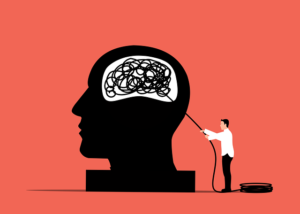Do you have trauma that you’re looking to heal? Eye Movement Desensitization and Reprocessing (EMDR) is a proven psychotherapy approach effective for the treatment of trauma. The goal of EMDR is to process your traumatic experience in a way that rewires the brain to react differently in the future to these memories of the trauma. But you may be wondering what is EMDR Therapy and how is it used?
Specifically, EMDR therapy changes the way that you store traumatic memories in your brain. EMDR often produces faster results than other traditional psychotherapy methods.
But what if you have other non-trauma issues you’re trying to heal? While initially developed for trauma, there are many uses for EMDR Therapy and conditions in which you can receive EMDR benefits. Before getting to that, let’s first look at why EMDR works.
Why Does EMDR Work
EMDR is based on the idea that symptoms result when trauma and other negative or challenging experiences overwhelm the brain’s natural ability to heal. This healing method includes standardized protocols that incorporate elements from many different treatment approaches.
During treatment, you work with your EMDR therapist to identify the sensations and emotions associated with the memory. Then you review the memory while focusing on an external stimulus that creates rapid (bilateral) movement between the left and right hemispheres of the brain. This can be done by watching the therapist move two fingers from side to side or by watching lights move back and forth on a bar. These side-to-side movements cross the body’s midline, inducing the brain’s bilateral stimulation.
If eye movements are a problem, alternate bilateral stimulation is used, such as small disks that alternately pulse when held in your hands or even the therapist alternately tapping your knees.
After each set of bilateral movements, you’re asked to briefly state what is coming up right then. Then the next set of bilateral stimulation starts. This process continues until the trauma has been processed and the memory is no longer disturbing.
According to the EMDR Institute, over 50 randomized studies have documented the effectiveness of EMDR therapy over the past 30 years for traumas including rape and sexual abuse, combat trauma, childhood abuse and neglect, life-threatening accidents, and disorders such as anxiety, depression, and substance abuse.
How Was EMDR Developed?
The EMDR method was developed by Francine Shapiro, an American psychotherapist. The catalyst event for developing the method was an experience she had as a graduate student in 1987. While walking in a park one day, she happened to be thinking about a familiar memory of a trauma she had experienced. Suddenly she noticed that the disturbing thoughts didn’t have the same negative intensity. Curious, she went back over what she had been doing while thinking of the memory. She realized that the only difference was that her eyes had been making a series of spontaneous movements from side to side and then up and down on the diagonal.
To test her observation, Shapiro started to move her eyes in the same pattern while focusing on different unpleasant thoughts and sad memories. Again, the negative thoughts lost their intensity. Curious about this phenomenon, she then asked other people at the research institute she was working in to do the same. She asked each to bring disturbing memories to mind while moving the eye as she had done. The results were striking. Their anxiety level about the memories decreased, and the participants reported handling distressing situations more calmly and realistically.
Shapiro went on to do controlled research about her observations, even basing her doctoral dissertation on the research. Her study and method, initially called Eye Movement Desensitization (EMD), was published in a professional journal. Other clinicians began replicating her studies and doing EMD with their own patients, and the method spread quickly in the psychotherapeutic community, spurring more research.
This research helped Shapiro distill the method into an 8-phase process, now renamed Eye Movement Desensitization and Reprocessing.
EMDR Process
- History and treatment planning: You describe the trauma and associated feelings with a therapist who will then work with you to develop a treatment plan.
- Preparation: The therapist will give you information about EMDR therapy and will help you practice eye movements.
- Assessment: To identify and evaluate the memory causing your emotional distress, the therapist will also teach you various imagery and stress reduction techniques that you can use during and between sessions.
- Desensitization: You will focus on your memory while simultaneously engaging in eye movements or another form of bilateral stimulation. As you process through the memory, new thoughts, feelings, images, and body sensations may emerge, and the memory loses its negative charge
- Installation: You then pair your memory to a new, positive belief. For example, “I survived it and I am strong” rather than the former belief of “I am disgusting and weak’.
- Body Scan: You will focus on your trauma at the same time as scanning your body for any sensation and determine if you feel the same as you did before EMDR.
- Closure: At the end of the session, you’ll learn what to expect at the next session as well as techniques to deal with any feelings or new memories that may emerge.
- Re-evaluation: At the start of the next session, the therapist evaluates your current psychological state, ensures the effects of treatment are still maintained, and addresses any new memories that may have emerged since the last session.
Each EMDR session is usually between 60-90 minutes, though they can be shorter. You can stop your provider at any time if you need to.
Side Effects of EMDR
Some people experience vivid dreams, lightheadedness, or an increased sense of awareness in the first day or two after an EMDR session. You might also feel waves of emotion, especially if you have experienced depression. These side effects may sound alarming, but they are completely normal – and are temporary. Just as you would expect to feel some pain or swelling around an injury on your body as it heals, these side effects indicate that your brain is reprocessing and healing.
It’s important that your nervous system has enough capacity to experience some negative charge, because you may experience a significant amount of discomfort confronting your traumatic event as you work through it. Your brain wants to cling to the familiarity of its old ways of thinking, even if the old ways are deeply harmful. So be honest with your EMDR therapist about how much distress you can handle. They can adjust their approach to ensure the process is not re-traumatizing to you.
How Long Does EMDR Take to Work?
The time it takes to reprocess trauma is different for everyone. However, there are a few factors that influence how long it may take. If you are seeking treatment after a single traumatic event such as an accident, the process may be quick – perhaps just a few sessions.
But if you’re undergoing treatment for prolonged trauma such as childhood abuse and trauma, it may take significantly longer. This is because during prolonged and ongoing trauma, your brain has more time to develop many neural connections that later lead to negative emotions. Single occurrences, while still impactful, don’t give the brain as much time to form these connections.
Another factor that can lengthen treatment is how much preparation your nervous system needs in Phases 2 and 3 to build sufficient capacity for the Phase 4, the desensitization phase.
Do Treatment Effects Last?
Multiple research studies have demonstrated maintenance of EMDR effects and outcomes even 5 years after a full course of treatment for PTSD (in these studies 12 sessions of EMDR meant the full course of therapy).
I also have experienced lasting results with my own experience as a receiver of EMDR. I had tried for years to change my seemingly automatic dissociation and flight response to being in the presence of someone’s anger. Talk therapy, self-help, and other efforts to find resolution came up empty. About 6 sessions of EMDR finally changed this automatic response. I can now be in the presence of another person’s anger, stay put, and maintain my composure.
Is EMDR an Effective Treatment for PTSD?
EMDR is the most widely researched psychotherapeutic treatment for PTSD of all treatments for PTSD. It has been recognized as an effective therapy for PTSD by the American Psychiatric Association. The Veterans Administration and the Department of Defense also placed EMDR in their top recommended treatments for PTSD. The World Health Organization cited EMDR as one of only two psychotherapies recommended for children, adolescents, and adults with PTSD.
These recommendations rest on how well EMDR has been empirically validated in over 30 randomized controlled studies. So yes, EMDR is an effective, research-backed treatment for PTSD.
EMDR for Substance Abuse
EMDR therapy is approved by the American Psychiatric Association (APA) and the World Health Organization (WHO) for the treatment of trauma. But many studies have shown EMDR’s effectiveness with other issues.
For example, it is effective and reliable in the treatment of trauma when co-occurring with substance abuse. It is common to suffer from co-occurring mental health disorders and substance abuse problems simultaneously. In many instances, trauma underlies one of these issues. So one way that EMDR is effective when substance abuse presents with a co-occurring disorder is through treating the past traumatic event to resolve the underlying trauma, often leading to decreased use of the abused substance.
Even if there haven’t been traumatic events underlying the substance use or co-occurring disorder, another way EMDR can be effective with substance abuse is in dealing with addiction memory. Addiction memory is the hard-wired memory of an addiction-related euphoria associated with a drug or alcohol use episode, which in turn can fuel substance abuse behavior. EMDR can be used to desensitize the memory of the “high” feeling that can be associated with substance abuse. To reprocess addiction memory using EMDR, the therapist targets your memories of craving and relapse.
EMDR for Depression
In studies examining EMDR as a treatment for depression, results showed it to be very effective, especially in cases of trauma-induced depression. Although trauma-induced depression shares many of the symptoms of other depressive disorders, there are some unique symptoms. These can include disillusionment, recurring flashbacks, and nightmares about the event.
Even in depression not induced by trauma, EMDR has been shown to be effective. In a 2014 study, researchers found that EMDR works as an additional treatment for depression. Indeed, a 2021 meta-analysis suggests that EMDR is an effective treatment for improving symptoms of depression.
One of the reasons EMDR can be helpful with depression is because it explicitly targets your negative beliefs and negative memories. Your focus on these beliefs and memories can prolong your depressive state. So, by reducing the felt, negative impact of these beliefs and memories, EMDR can diminish what is fueling your depression.
EMDR for ADHD
Genetics are an integral part of developing ADHD. However, recent studies have also shown a link between childhood trauma and the onset of ADHD. The condition does seem to present differently in children who have experienced trauma in comparison to those who have not.
Many people with ADHD may have “small t” traumas meaning they may have had day-in-day-out chronic experiences while growing up that left them with self-esteem issues, anxiety, and struggles with negative mood. EMDR can address these issues in part by adapting the EMDR framework to work with your ADHD needs. For example, external forms of bilateral stimulation can be added, such as tools for drawing or video games. This can reduce anxiety, allowing you to better follow instructions and to reprocess “small t” traumas.
Overall, EMDR can reduce symptoms successfully and lessen the effects “small t” trauma, specifically improving emotional regulation, frustration management, problem-solving, and responsiveness to tasks.
EMDR for OCD
Research shows that EMDR can also be used to treat obsessive-compulsive disorder (OCD). One review found nine studies on using EMDR for OCD, and all of them showed that it improved OCD symptoms. For example, a 2019 study involved eight people whose OCD symptoms did not improve after the more traditional treatment of Cognitive Behavioral Therapy, yet EMDR was effective at reducing symptoms for each of the eight people.
While trauma doesn’t appear to be a main cause of OCD, stress can trigger the onset of OCD if you’re already at risk. When using EMDR therapy for OCD, the therapist treats each your obsessions and compulsions as a current ongoing trauma. EMDR protocols focused on treating current trauma help you process your ongoing obsessions in a similar way to how it helps process past traumas.
EMDR for Anxiety
You may have seen the recent documentary or heard about Prince Harry using EMDR to help with the effects of anxiety and trauma from the death of his mother 20 years ago. That news may have you wondering if you can use EMDR for anxiety.
As you know now, EMDR therapy initially focused on treating post-traumatic stress. However, there is a close relationship between trauma and anxiety. The use of EMDR in the treatment of anxiety disorders targets the processing of related disturbing memories, which in turn reduces or eliminates the symptoms of anxiety.
Over the last 20 years, there have been at least six randomized controlled trials (RCTs) investigating the use of EMDR for adults with anxiety disorders. Four of them demonstrated a positive effect on panic and phobic symptoms.
A 2020 meta-analysis of randomized, controlled studies exploring EMDR as a treatment for anxiety suggests that it effectively reduces the symptoms of anxiety, including panic, phobia, and related somatic (body) behavior. Given that 30 percent of people experience anxiety in their lives, that is important and hopeful information.
Treatment for Social Anxiety Disorder
Another type of anxiety treatable with EMDR is social anxiety disorder, also known as social phobia. Social anxiety disorder involves crippling discomfort in social situations. You feel anxiety and fear of being negatively judged and evaluated by others. The resulting anxiety can fuel isolation, which contributes to further deterioration of social skills and confidence. This, in turn, reinforces the social anxiety in a frustrating cycle.
An EMDR therapist can help you change the way you think about social situations through a process of targeting negative memories that sparked anxiety while simultaneously utilizing bilateral stimulation techniques. The process of EMDR for social anxiety removes the negativity from your thinking concerning social experiences and replaces it with more positive imagery and feelings. EMDR changes the way your brain stores memories.
While there are other therapies used for social anxiety, EMDR can also be used as the main treatment or as an adjunct to other therapies.
EMDR for Pain Management
Pain management is complicated, so first some background. In many people, chronic pain persists despite treatment of the underlying disease or injury that originally caused the pain. In addition to pain’s sensory dimension, pain usually contains an emotional dimension. As your pain becomes chronic, a shift in your brain’s processing occurs, moving it from the typical pain processing regions of the brain to emotional networks in the brain. It’s somewhat like flashbacks in Post-Traumatic Stress Disorder, and it is the reason that your pain persists.
According to Dr. Monty Lyman, injury is neither necessary nor sufficient for pain to be felt. This explains why the degree of pain you experience is not directly proportional to the extent of your injury. Pain is not created in the damaged tissue and doesn’t travel up the nerves to your brain. Instead, there is a complex network of neurons that can either let signals through or block them. The context in which pain is experienced will influence your expectations and your brain’s assessment of danger. Whether your body is actually in danger or injured may not correspond to the level of pain.
For example, a trigger that brings up a memory of domestic violence may cause feelings of danger and the experience of pain – even if no danger exists in the present. Similarly, the chronic experience of negative emotions and feelings, especially anxiety and stress, can cause the transition from brief short-term pain to long-term chronic pain. Your brain becomes “rewired” to expect pain even when the initial injury has healed.
Studies Using EMDR for Chronic Pain
When you experience pain relief, it’s not a direct consequence of healing in the body. Rather, your brain recognizes that healing has taken place or that the danger of injury has been removed. As a result, your brain reduces your perception of pain. Multiple studies have shown a significant improvement in pain intensity following EMDR intervention.
In fact, one of the first randomized trials on EMDR examined the effect of a modified EMDR process on acute migraine attacks. All participants were treated during the mid to late stages of a migraine attack. Both groups in the study showed a reduction in migraine pain immediately after treatment and seven days later. However, the group that received integrated EMDR treatment reduced or eliminated migraine pain more rapidly. It also showed significantly greater improvement compared to conventional medication.
Similarly, a 2018 study involved patients with chronic musculoskeletal pain due to rheumatoid arthritis. The participants were assigned to one of two intervention groups or one “treatment as usual” control group. EMDR was provided to one intervention group and Guided Imagery was provided to the other. EMDR resulted in better outcomes than both rehabilitation treatment and Guided Imagery.
Is There Any Reason I Shouldn’t Have EMDR Therapy?
So, now you know that EMDR is used for PTSD treatment, as well as substance abuse, depression, OCD, anxiety, phobia, chronic pain, and many other mental health conditions. However, sometimes EMDR should not be used or it should be used with caution.
Because EMDR therapy can briefly intensify emotion and body sensations during the session, you may want to talk to your doctor first if you have a condition like seizures or another neurological disorder. As with other health treatments, it’s a good idea to check it out first with your doctor if you’re pregnant.
Successful EMDR treatment is built on stability. If you find yourself feeling suicidal or experiencing psychosis before or after EMDR, wait to do another EMDR session until you stabilize again. And be sure to tell your therapist right away about your feelings and experience!
If you take a psychotropic medication or use non-regulated substances, definitely tell your EMDR therapist. Also if you have an eye condition, have had eye surgery, or wear contact lenses, tell the therapist before starting EMDR.
If you suspect that you dissociate more than just daydreaming, make sure the EMDR therapist you select has received training in treating people with dissociative disorders.
A final caution: If your trauma generated a legal case, think carefully about doing EMDR therapy before the case resolves. EMDR generally resolves symptoms, and it’s particularly effective for single incident shock traumas. So it could affect your testimony or influence the perception of a judge or jury concerning the trauma’s impact on you.
Finding an EMDR Therapist
At Life Care Wellness we can help you work through PTSD, anxiety, depression, and more. We have trained EMDR therapists who can help you to heal. If you are in the northern Illinois area, please reach out to us in our Glen Ellyn, Chicago (Jefferson Park), Sycamore, or Yorkville locations to set up an EMDR session. To find an EMDR therapist near you in other areas, check the EMDR Institute directory.
Rhonda Kelloway is the owner and principal therapist at Life Care Wellness, a group psychotherapy practice in Glen Ellyn, Chicago (Jefferson Park neighborhood), Sycamore, and Yorkville, Illinois. She is a trauma specialist utilizing a Somatic Experiencing framework to utilize the body’s wisdom in healing. She also uses EMDR and a variety of traditional psychotherapy approaches in her work. In addition to being a psychotherapist, she is a trained divorce and family mediator.








